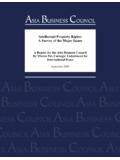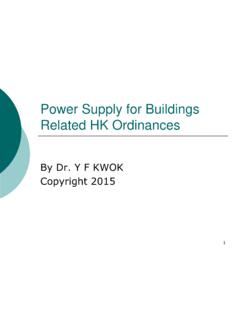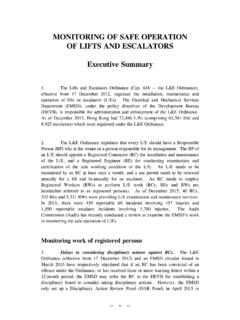Transcription of Energy efficiency building standards in Hong Kong
1 Energy efficiency building standards in hong Kong Status of building Energy efficiency standards hong Kong s efforts to develop building Energy standards started in 1990, when the government commissioned a consultant report on building Energy regulations. That report recommended that hong Kong adopt an OTTV (Overall Thermal Transfer Value) standard for the building envelope; hong Kong introduced such a building ( Energy efficiency ) Regulation in July 1995 with suitable OTT values for the walls and roofs of commercial buildings and hotels. Commercial buildings refer to offices, shops, department stores, and other buildings with commercial purposes, but do not include schools, residential buildings, factories, or garages. In practice, the code has been applied to any air-conditioned building .
2 The Buildings Department published a code of Practice for Overall Thermal Transfer Values in Buildings (OTTV code ) to provide technical guidance on the OTT values. In addition to the OTTV standard, which affects only the construction of the building envelope, the hong Kong government also develop separate standards for lighting, air-conditioning, and electrical equipment (all in 1998), and for lifts and elevators (2000). Thus, by 2000 these five standards together contained the same scope as more comprehensive standards such as ASHRAE in the US. In 2005, all five of these standards were revised, with a performance-based option added to the building envelope standard. Contents. An OTTV standard limits the maximum allowable thermal transfer value, , heat gain in cooling-dominant locations, for a building or portion of a building in W/m2.
3 The concept was originally proposed in the US for the ASHRAE 90-75 Standard in 1975, but subsequently dropped in later versions in favor of performance-based Energy budgets generated through computer simulations. However, the OTTV method is still being used in a number of Asian countries or cities, including hong Kong, Singapore, Thailand, Malaysia, etc., because of its relative ease of calculation, while still providing some flexibility of trade-offs between different parts of the envelope. The shortcoming of the OTTV method is that it does not account for the interactions between the envelope, internal gains, and equipment efficiency , as would a true performance calculation. Since most commercial buildings in hong Kong consist of a tower on top of a larger podium, the 1995 standard contained different OTTV criteria of 35 W/m2 for the tower and 80 W/m2 for the podium.
4 In 2000, the building envelope standard was revised, with the OTTV criteria reduced downwards from 35 to 30 W/m2 for the tower, and from 80 to 70 W/m2 for the podium. In 2005, there was a major effort to update the four standards for lighting, air conditioning, electrical power, lifts and elevators, as well as add a performance approach to the building Energy code . This performance approach is not meant to replace the five pre-existing standards , but to provide an alternate path of compliance by use of computer simulations to show that the proposed building uses the same or lower amount of Energy than does a reference code -compliant building of the same size and function. 1. Compliance Framework for hong Kong building Energy standards Figure 1 shows how the five standards and performance approach are related conceptually.
5 Regardless of which approach is used, there are basic requirements for a building to comply, If the prescriptive approach is used, the building must meet separately the prescriptive requirements of the envelope, , OTTV criteria, lighting,, HVAC, electrical e and lifts and elevators standards . Otherwise, with the performance approach a computer simulation is done to demonstrate that the overall Energy use of the building is below that of a hypothetical reference building . Beneficial features of the hong Kong standards are that (1) they are freely available on the Web, and (2) each standard contains the standardized forms that users can fill out to demonstrate compliance. Jurisdiction. The hong Kong building Energy standards are voluntary codes. The Electrical and Mechanical Services Department (EMSD) of the government is in charge of issuing the codes of practice, including the building Energy codes.
6 In 1994, EMSD established an Energy efficiency Office (EEO) to provide technical expertise and promote adoption of the codes, as well as promote Energy efficiency and conservation programs. To promote adoption of the voluntary standards , EMSD established an Energy efficiency Registration Scheme for Buildings in 1998. Designers, developers, property management companies, etc., can submit details of their building for assessment. If the EEO determines that the building is in compliance with the standards , a registration certificate will be issued, and the building can use the scheme s Energy -efficient building logo on their documents to publicize their achievement in Energy efficiency (see Figure 2). As of December 2006, 1722 registration certificates have been issued for 713 building venues.
7 Status of Non-Regulatory Programs In addition to the voluntary building Energy standard, EMSD has also developed supportive non-regulatory programs such as establishing Energy consumption indicators and benchmarks. Benchmarks have been established for offices, commercial outlets, hotels and boarding houses, universities, post-secondary colleges and schools, hospitals and clinics, private cars, light goods vehicles, medium goods vehicles, heavy goods vehicles, privates light buses, and non-franchised busses. The website for this program ( ) contains plots of the Energy use of the buildings in the data base (Figure 3 shows the Energy use of shopping centers). The website also contains an on-line benchmarking tool that allows users to enter their Energy consumption.
8 Related end-use efficiency programs EMSD operates a voluntary Energy efficiency Labeling Scheme for appliances, home and office equipment, and vehicles. The scheme now covers 17 types of household appliances, including refrigerators, room coolers, washing machines, electric clothes dryers, compact fluorescent lamps, electric storage water heaters, electric rice cookers, dehumidifiers, televisions, electronic ballasts, and gas-fired instantaneous water heaters. Office equipment covered in the scheme includes photocopiers, multifunction devices, laser printers, LCD monitors, computers and fax machines. Figure 2. Energy -Efficient building Logo Contacts References: Ho, Paul 2000. Modeling Thermal Performance of building Envelope in hong Kong , in the Journal of building Surveying, Vol.
9 2 (1), pp. 21-26. For more information, visit











